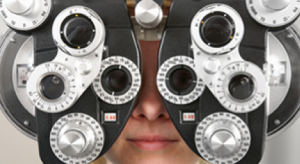
by Dr. Paul Raybon
I made my annual trip to the eye doctor last week. When you read for work and pleasure as well as spend a lot of time in front of a computer screen, you take care of your eyes. I’m always fascinated by the whole process. Having pictures taken of the inside of your eye, trying not to blink when the puff of air comes, and then sitting in the big chair while the doctor smoothly manipulates the lenses on the phoropter (new word for the day!) asking repeatedly “Which set of letters is clearer, this one or this one? Then “Tell me when the letters line up,” and “Tell me when the two images merge into one.”
As I prepare to lead a visioning process at my own church, my visit to the eye doctor reminds me of a few truths about the vision of the church.
- Health is the first concern. Before my doctor and I talk about glasses, we talk about the health of my eyes. Are there signs of eye disease or cataracts clouding my vision? Are there indicators of other serious health issues showing up in my eyes (like diabetes, cancer and stroke)? When we gather to talk about casting a vision for the future of our congregations we need to take time to look at the spiritual health of our church. What’s working? What’s not working? Are there signs of emotional and spiritual illness that need to be addressed?
- Get an accurate picture before you start correcting. My doctor takes the time to ask how I’m feeling and what I sense is going on with my vision. He also takes precise measurements of my eyes and vision. Together the subjective and objective examinations present a more accurate picture of what is needed. As we begin to look at our churches’ future we don’t depend solely on our feelings, our observations, or crunching numbers, but a combination of information that allows us to see where we are right now.
- Don’t consider at all the options at once. That amazing phoropter has over 200 lenses which can produce multitudes of combinations. But the doctor only presents you with two choices at a time. “Which one looks better?” In congregational visioning we use discerning consensus to determine which options we want to consider first. Hold the other options in reserve in case the chosen paths don’t lead where we need to go.
- Look for congruence. The doctor is making sure that both eyes are going to be seeing the same thing. If the congregation doesn’t sense that things are coming together and we are moving in the same direction together, then pause and make sure that we are all looking at the same target and moving with the same intent. Sometimes, maybe always, when a person say “yes” they are agreeing to their interpretation of the choice before them.
- Don’t cheat. When the doctor asks “Which line can you read clearly?” The part of me that wants to do well on a test is tempted to squint and guess at a line too far down the screen. That is a good way to end up with lenses that don’t do enough correcting for clear sight. As we pursue a congregational vision we are tempted to squint our eyes, or maybe put on our rose colored glasses, and try to imagine things are better than they are. Being honest in our assessments helps us know what really needs to be done to move us ahead towards God’s calling for our congregation.
Dr. Paul Raybon, our partner in ministry for Western North Carolina and the Upstate South Carolina, is Associate Pastor at Hominy Baptist Church near Asheville, NC and works with churches and leaders as a coach and consultant in visioning, administration, and spiritual formation. For more information about how he can help you, contact him at [email protected].
